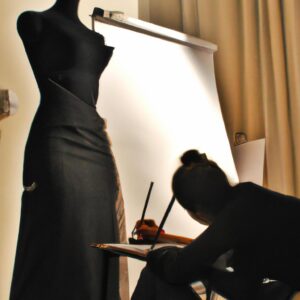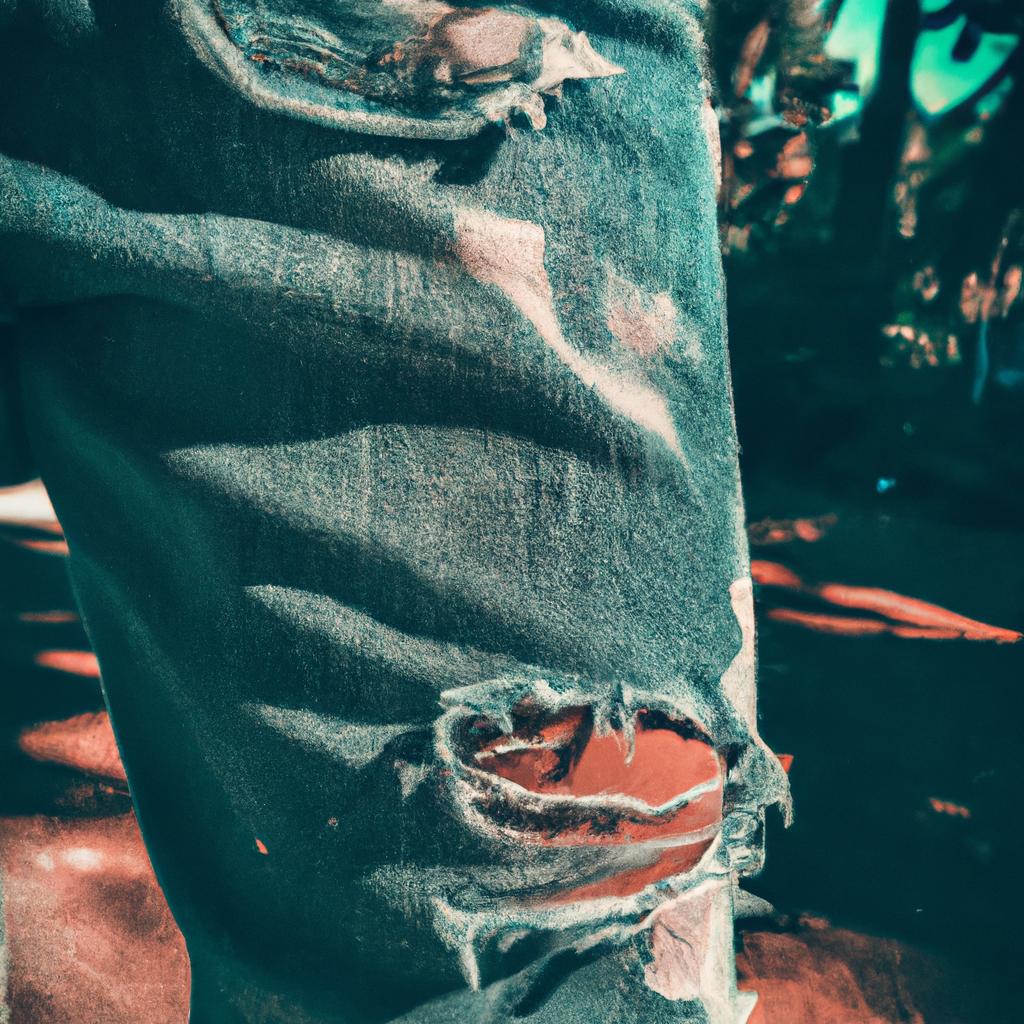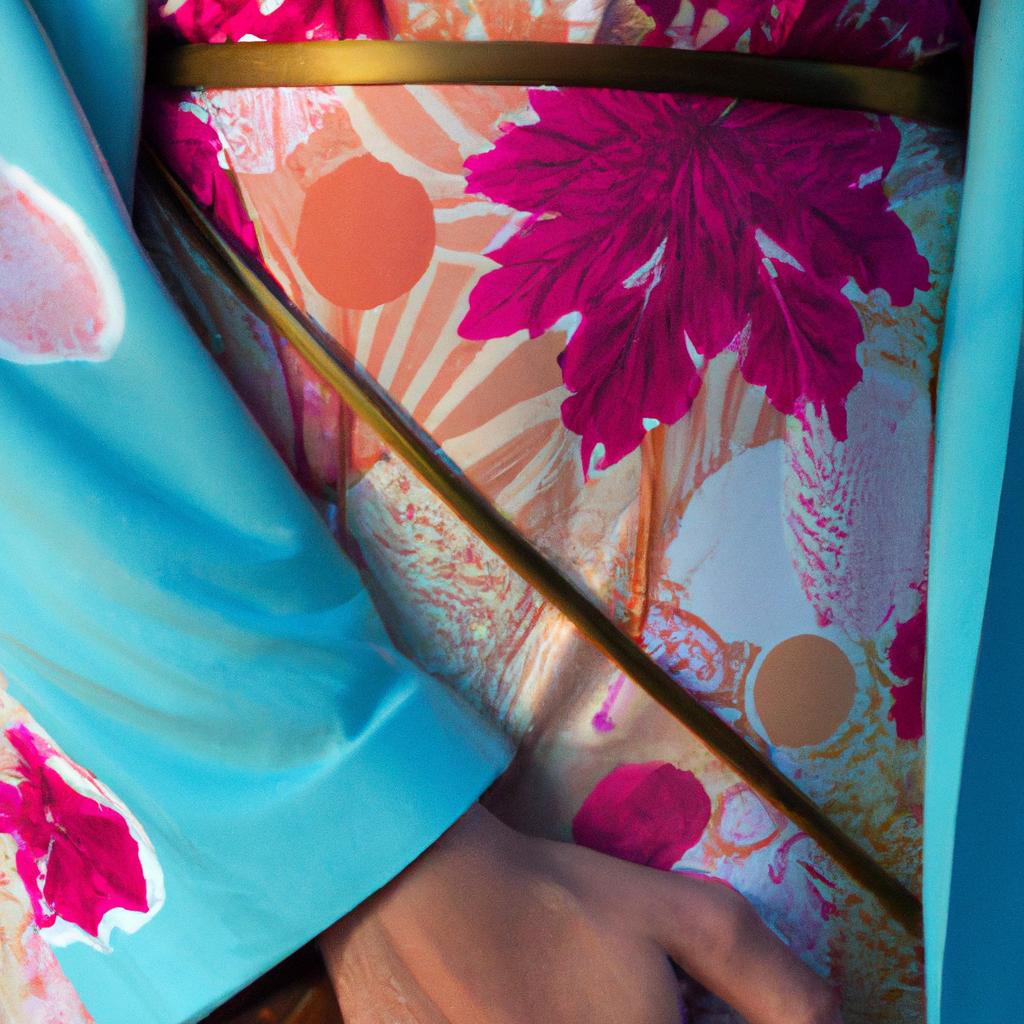Fashion illustration is a form of art that has been used for centuries to create visual representations of clothing designs. It is an integral part of the fashion design process, and has been used by top fashion designers to present their ideas to buyers and the public. Fashion illustration is used to bring a designer’s concepts to life, translating them from flat sketches on paper or in digital form into three-dimensional illustrations.
This type of illustration can range from quick sketches to highly detailed renderings. The illustrations are often used as the basis for the creation of actual garments, although they can also be used to express the overall vision and theme behind a collection or line of clothing.
For aspiring fashion designers, fashion illustration is a great tool for honing their skills and expressing their creative visions. It gives them the chance to draw out the silhouettes they are imagining and make sure they are creating something unique and attractive. By mastering the techniques of fashion illustration, aspiring designers can gain confidence in their design abilities and present their work more effectively.
Breaking Down the Process of Fashion Illustration
Properly understanding fashion illustration requires breaking down the process to better understand each step. It is a complex and detailed art form that requires many different aspects to come together to create stunning illustrations. From conceptualizing a garment, to adding color and texture – fashion illustration involves a lot of elements.
The first step is to visualize a concept before even starting to sketch. Think about what kind of silhouette, fabric, color, and details the desired garment might have. The more consecutive ideas you can come up with, the more you can incorporate into your fashion illustration.
Once you have the basic idea down, the next step is to sketch the concept. Using pencils, pens, or any other drawing tools available, make sure to have plenty of paper around to effortless transition between ideas. Consider the light and dark shading that depicts wrinkles and structure points in clothing.
The third step is to begin to add color and texture. Working with watercolor paper or a similar type of material can help bring your fashion illustrations to life. Applying brush-style strokes, blending colors, and adding shadows and depth to the garment can create the desired look.
The fourth step is creating an outline around the illustration so it has sharper lines and an added 3-dimensional look. Tracing over the illustration with black ink creates a boundary for the garment design.
Finally, the last step is to add final details, such as accessorizing the illustration with jewelry or adding logos and buttons. This helps to tie the concept together and truly turns the sketch into a finalized fashion illustration.
Overview of Tools Used in Fashion Illustration
Fashion illustration is an intricate and detailed art form that requires specific tools and techniques to create beautiful, eye-catching sketches. This section will discuss the essential tools and materials needed to make successful fashion illustrations.
- Pencils: A quality pencil set is a must-have for fashion illustration. Pencils come in a variety of different hardnesses, from soft to hard. Soft pencils are ideal for shading and creating shadows, while hard pencils are better for outlining and drawing details.
- Eraser: An eraser is also important when it comes to fashion illustration. Whether it’s a kneaded eraser or a gum eraser, having one on hand helps correct mistakes and refine drawings.
- Pens: Pens are a great tool for adding crisp lines and details to fashion illustrations. Technical pens, fine-liner pens, and brush pens are all common tools used in fashion illustration.
- Markers: Markers are great for adding vibrant colors to illustrations. They come in a range of vibrant colors and can be used to give illustrations added depth and dimension.
- Paper: Quality paper is also essential for fashion illustration. Thick paper holds up well and is great for layering and blending colors. Thinner paper is more lightweight and easier to draw on, so artists may find it useful to have both types on hand.
These are just some of the tools that are essential for fashion illustration. Experienced artists may choose to add other materials such as watercolors, brushes, and colored pencils to their tool kit. Having the right tools is an important part of creating successful fashion illustrations.
Step-by-step guide for illustrating a garment concept
The world of fashion illustration is exciting and can help aspiring designers express their ideas in unique ways. This step-by-step guide will show you how to create a garment concept from your ideas.
First, gather the necessary supplies: paper, a pencil, an eraser, and colored pencils or paints. Depending on what you plan to illustrate, other supplies may be needed. For example, if you plan to create sketches of a handbag or other accessory, it may be helpful to have a reference image of the item.
Next, decide what type of drawing you wish to create. This could include a basic sketch or a more detailed image with shading, color, and texture. Figure out your goal for the piece before you begin.
Once you have chosen your goal, plan out your composition. Consider where to place the garment, if there should be a model, and what colors and textures to use.
Now you are ready to start illustrating your concept. Begin with a loose sketch of the garment, focusing on major shapes and details. Then refine the sketch until it is complete. If you are using color, remember to add shading and highlights to make the drawing look more realistic.
Finally, go back and make any final touches. Add subtle details or small elements that can make your illustration stand out. Make sure the proportions of the garment are correct.
With practice and dedication, you can perfect the art of fashion illustration. So why not start creating your own garment concepts today?
Adding Color and Texture to Fashion Illustrations
When creating fashion illustrations, adding color and texture is the final step. This will give your design a realistic finish and will help you bring your concept to life. Color and texture will also make the design more striking and aesthetically pleasing.
You don’t need to be a professional artist to create color and texture for your fashion illustrations. There are a few techniques to help you get started.
- Using color pencils or markers to go over your sketches. This will help you add bold colors and patterns to the fabric of the garment.
- Drawing on watercolor paper and painting over your sketches with water-based paints. It will also help to use different brush sizes and textures to create more depth in the clothing.
- Applying colored pastels to the illustration by rubbing it gently onto the paper. You can also layer the colors to create a unique effect.
- Using Photoshop to digitally colorize your illustrations. With this method, you can easily manipulate colors and tones.
By mastering all the techniques discussed above, you will be able to create stunning fashion illustrations that will stand out from the crowd. Color and texture will bring life to your designs, giving them a unique look and appeal.
Exploring How To Share Fashion Illustrations with the Wider Community
Fashion illustration is a powerful way to express creativity, and sharing it with the world can yield some powerful results. Whether you are sharing digitally on social media platforms or submitting to fashion magazines, having a precise and professional portfolio is essential.
If you are sharing your illustrations online, there are few key things to consider. First, it is important to be mindful of copyright regulations. It is important to protect your work and ensure that any images you share reflect ownership accordingly. Additionally, when posting on social media platforms, remember to add hashtags that are relevant to the fashion industry. This will help increase your reach and attract more eyes to your work.
When submitting your work to magazines, publications, or even fashion shows, be sure to include a strong bio to accompany your illustrations. This will give potential employers an understanding of who you are, your background, and the inspiration behind the artwork you produce.
How you present your work is also critical. It is best to provide a well-designed, easy to follow portfolio that showcases your best illustrations. Furthermore, given the visual nature of fashion illustration, it is important to also include photographs of any garments modeled after or based on the illustrations.
Before you dive in and start sharing your work, take the time to find several sources of inspiration. This could range from fellow fashion illustrators to blogs to fashion industry events and publications. Knowing what’s current and popular throughout the industry will allow you to stay ahead of the game and perfect your skills as a fashion illustrator.
What Fashion Illustration Can Mean For Aspiring Designers
Fashion illustration is a unique and creative art form that has the potential to open many doors for aspiring designers. Not only can it help to attract potential clients, but it can also give designers the chance to showcase their designs in an artistic way. Through fashion illustration, aspiring designers can demonstrate their ability to combine elements of art and design to create beautiful pieces which can be showcased in catalogs or on the runway. Additionally, fashion illustration can be used to better express the designer’s individual style, helping them stand out from the crowd.
Fashion illustration can also be used to market and promote existing collections, or even used to develop new collections and explore further possibilities. By taking the time to illustrate each aspect of the designs, the designer can gain greater insight into how their vision will translate into physical garments.
Through fashion illustration, aspiring designers can train their eye to recognize important details, such as proportion, texture, and silhouette. This is a crucial part of any successful design process because it allows the designer to make adjustments and evaluate the design results beforehand. Furthermore, a well-crafted illustration can help designers speak more easily about their design concepts which may help them secure investors.
Ultimately, fashion illustration can be an invaluable tool for aspiring designers. It not only has the potential to highlight the designer’s unique voice, but it also offers them a powerful means to express their ideas, share their results, and market their designs.
Examples of Fashion Illustration Artwork Featured on the Runway
Fashion illustration has been used for centuries in a range of forms and contexts. Today, fashion illustrators are still celebrated for their artistry on the runway, where they showcase their designs alongside traditional garments.
From sketches to full-on illustrations, these runway shows boast colorful, dynamic visuals that captivate audiences. Each season, more and more fashion brands are turning to fashion illustrations to bring their collections to life. In some cases, an entire collection may even be based on a single fashion illustrator’s artwork.
Fashion illustrations on the runway can include everything from abstract shapes to detailed sketches of garments. Some fashion designers will use illustrations of people to depict their designs as part of a complete look. Sketches of smaller accessories, such as handbags or shoes, are also popular additions to any runway show.
Fashion illustration on the runway acts as an opportunity to create dynamic visual story-telling. These illustrations may feature dramatic colors, brushstrokes, and lines that evoke emotion and tell a unique story. This kind of expressive artwork instantly draws attention to the collection and allows the designer to express their creative vision.
Interview with a Successful Fashion Illustrator
We chatted with successful fashion illustrator, Joanna Hammond, to learn more about her career and the value of fashion illustration.
Hammond talked about the importance of having an eye for detail and realism in fashion artwork. “Fashion illustration requires an understanding of shape, structure, fabric, and color. You have to be able to envision a garment as it would look on the runway and translate that onto paper,” she said.
When asked what inspires her artwork, Hammond explained that she draws influence from all kinds of sources. “Anything from street fashion, to classic fashion icons like Coco Chanel. I’m even inspired by interior design trends, patterns and fabrics. All of these pieces come together to create something unique and often unseen in the fashion world,” she said.
Finally, Hammond emphasized the importance of staying up-to-date with trends in the fashion industry. “The way we dress is constantly changing, so it’s important to stay ahead of the curve. You have to know what’s ‘in’ and what’s ‘out’ so that your illustrations reflect the best of current fashion trends,” she said.
The History of Fashion Illustration
Fashion illustration has a long and fascinating history, one that reaches further back than you might think. As far back as the 15th century, artists have been creating fashion illustrations as a way to capture and share their vision of fashion. From the early days of hand-drawn sketches to the more complex illustrations we see today, fashion illustration has come far in terms of both technique and scope.
In the 1700s, fashion illustrations took on a wider audience and were used to advertise the latest styles for both men and women. Magazine illustrations also became popular during this time, as they allowed designers to showcase their latest collections without having to do a physical fitting or studio shoot. By the late 1800s, fashion illustration had become an art form of its own, with the work of such iconic fashion illustrators as Paul Iribe and George Barbier being showcased at prestigious galleries around the world.
In the 1900s, fashion illustration underwent a distinct transformation as modernized printing and photography techniques made fashion magazines more accessible and widespread. Famous illustrators like Erte, Rene Gruau, and Antonio Lopez revolutionized the art of fashion illustration and pushed it into new directions. They pioneered the use of exaggerated poses, vibrant colors, and emotion-filled faces to create powerful visuals that captured the essence of the fashion industry.
Today, fashion illustration is still evolving, with new digital tools and software allowing illustrators to create more intricate and realistic works than ever before. Fashion illustration continues to be an important art form for those looking to break into the fashion industry, offering aspiring designers an affordable and creative way to get noticed and showcase their talents.
The Benefits of Fashion Illustration for Aspiring Designers
Fashion illustration has many benefits for aspiring designers, from helping to bring their creative visions to life to offering an effective way to market their looks to potential clients. Drawing fashion illustrations can help bring a designer’s sketches and concepts to life, making them easier to communicate with the wider creative community. Through fashion illustration, ideas can become real-life products.
Fashion illustration also serves an important purpose in the world of marketing. With fashion illustrations, a designer can create realistic drawings of their clothing that will capture the attention of potential clients and buyers. This can help designers take their designs to the next level by introducing their work to a broader audience.
Furthermore, fashion illustration helps aspiring designers create visuals of how their clothing will appear on the runway. In addition to helping them develop their own aesthetic, fashion illustration allows designers to imagine how their garments will look on the catwalk, helping them create pieces with the right balance of form and function.
Finally, fashion illustration can be used to create virtual portfolios that showcase a designer’s most innovative designs. By using fashion illustration to capture the essence of their work, aspiring designers can create attractive portfolios that enhance their chances of landing lucrative fashion deals.
Conclusion
Fashion illustration is a creative and powerful form of art that can be used to express ideas and bring them to life on paper. It has been a part of the fashion industry for centuries, and it continues to play an important role today. Fashion illustration allows aspiring and current designers to create tangible visuals of their concepts and share those with the wider community. It also provides a unique way of expressing one’s creativity and talent.
Fashion illustration is a great tool for aspiring fashion designers to use as part of the design process. It can help in bringing ideas to life and helping designers refine their concepts to ensure they are best presented for potential success. Additionally, fashion illustration is a vital marketing tool, as it can help showcase garments, branding, and collections in a visually attractive and captivating manner.
Now that you have a better understanding of the art of fashion illustration, you can become a fashion illustrator yourself. Fashion illustration is a skill that can be developed with practice and dedication. With the right amount of hard work and persistence, you can become a skilled fashion illustrator and create visuals that will leave your audience inspired.
comments: 0




